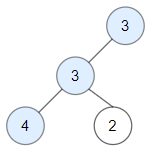Problem
Given a binary tree root, a node X in the tree is named good if in the path from root to X there are no nodes with a value greater than X.
Return the number of good nodes in the binary tree.
Example 1:
Input: root = [3,1,4,3,null,1,5]
Output: 4
Explanation: Nodes in blue are good.
Root Node (3) is always a good node.
Node 4 -> (3,4) is the maximum value in the path starting from the root.
Node 5 -> (3,4,5) is the maximum value in the path
Node 3 -> (3,1,3) is the maximum value in the path.Example 2:
Input: root = [3,3,null,4,2]
Output: 3
Explanation: Node 2 -> (3, 3, 2) is not good, because "3" is higher than it.Example 3:
Input: root = [1] Output: 1 Explanation: Root is considered as good.Constraints:
・ The number of nodes in the binary tree is in the range [1, 10⁵]. ・ Each node's value is between [-10⁴, 10⁴].
Idea
난이도는 medium으로 되어 있으나 문제를 풀다보면 easy라는 생각이 드는 문제다. 알고리즘은 다음과 같다.
- Tree를 탐색하면서 해당 path의 최대값을 넘겨준다.
- 현재 node의 값이 최대값보다 크거나 같을 경우 리턴할 값에 1을 더하고 최대값을 node의 값으로 바꾼다.
- 모든 tree를 탐색한 후 값을 리턴한다.
Solution
class Solution { int ans; public int goodNodes(TreeNode root) { traverseTree(root, Integer.MIN_VALUE); return ans; } private void traverseTree(TreeNode node, int maxValue) { if (node == null) return; if (node.val >= maxValue) { ans++; maxValue = node.val; } traverseTree(node.left, maxValue); traverseTree(node.right, maxValue); } }
Reference
https://leetcode.com/problems/count-good-nodes-in-binary-tree/


